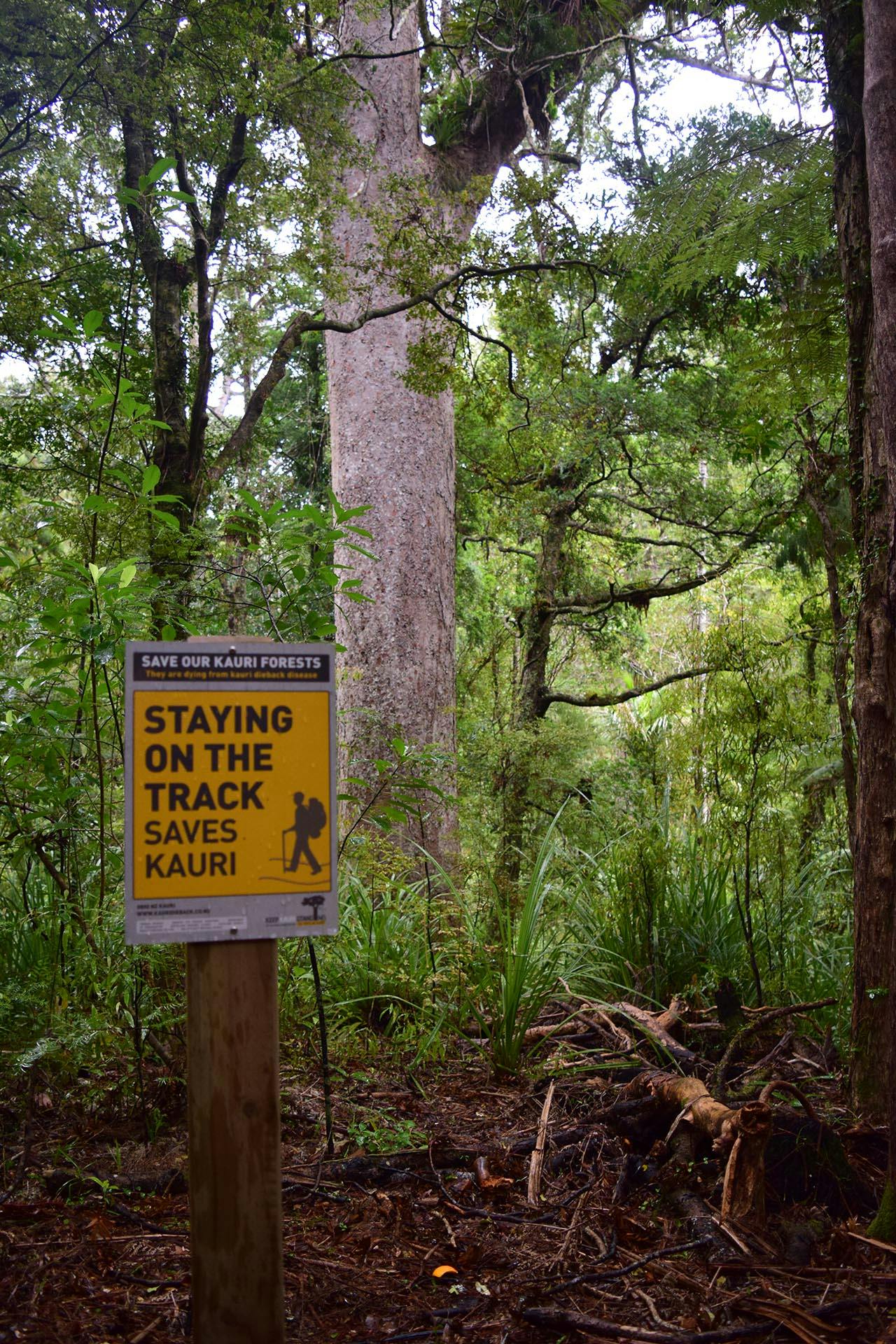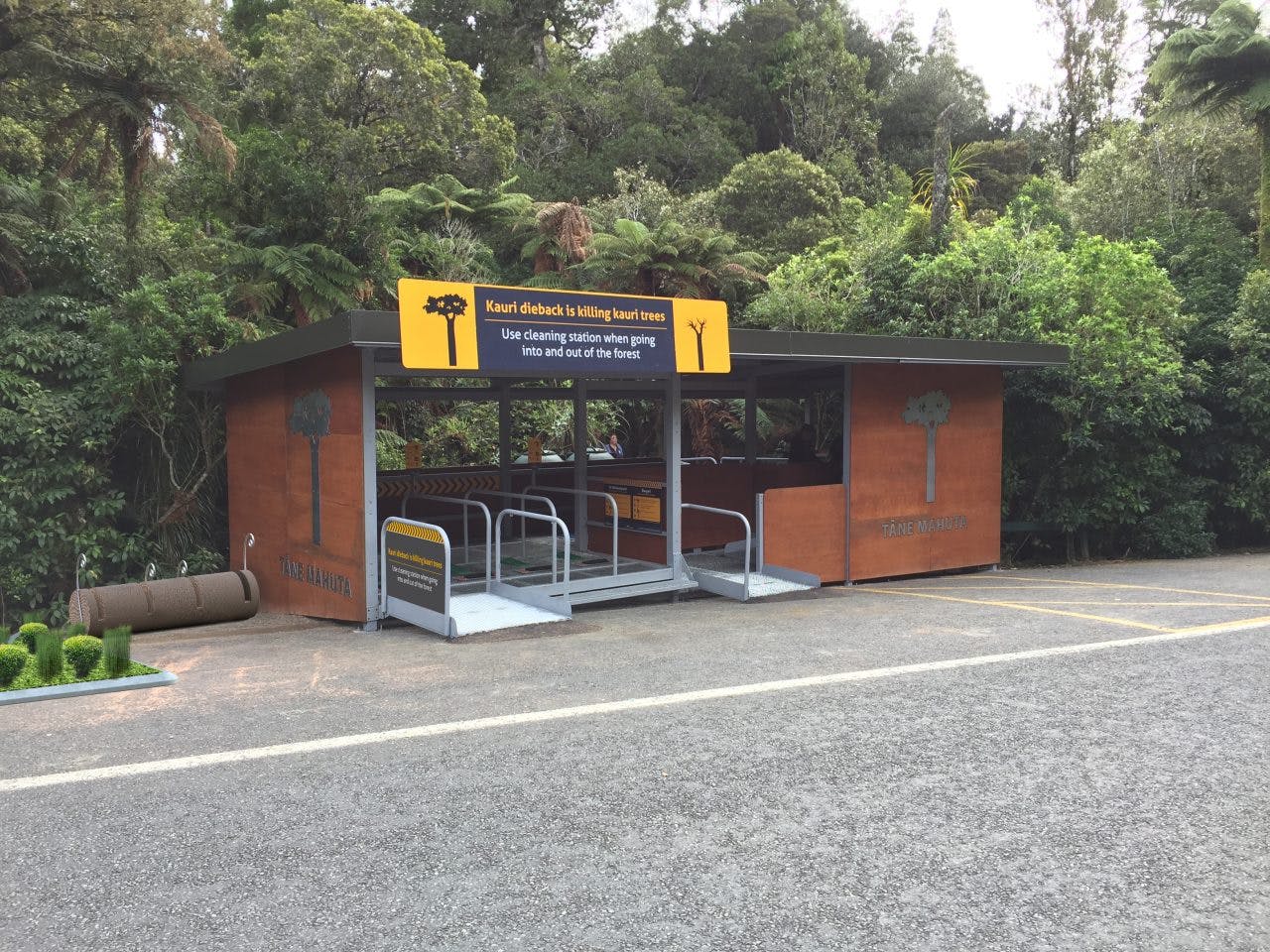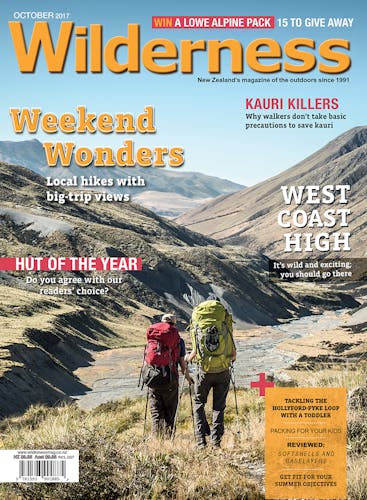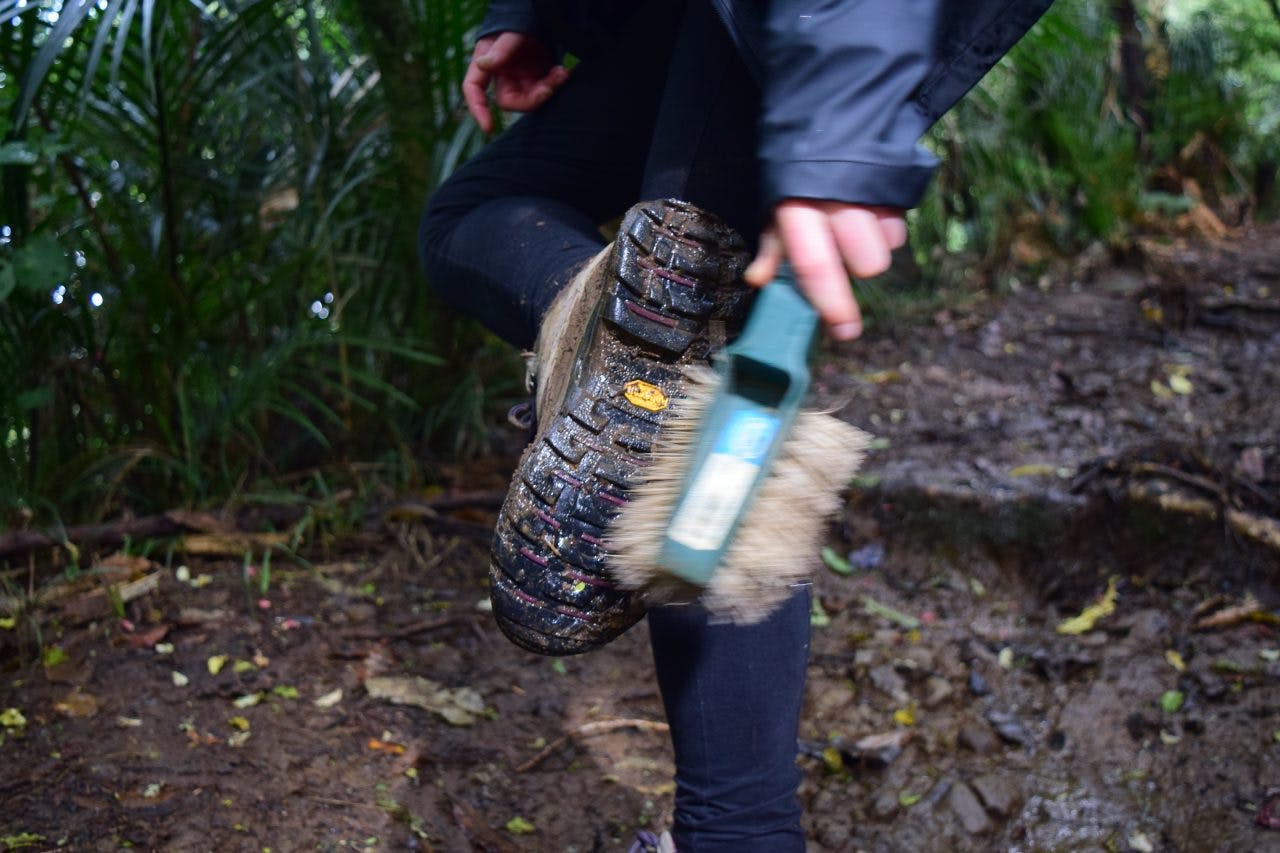A disease smaller than a pinhead is bringing down the oldest, largest trees of the forest and it is being spread by the very people who should value and respect this taonga the most. George Driver investigates why so many people ignore advice to prevent the spread of kauri dieback disease.
The car park is overflowing when I pull into the entrance of the Fairy Falls Track in Auckland’s Waitakere Ranges Regional Park. A group of weekend walkers is gathered, donning trainers and raincoats, setting off on a Sunday hike. I hang back and watch as the group walks past a black barrel and a scrubbing brush beside a sign asking them to ‘Save our kauri forests’. Some of the group slow down, glancing at the sign before carrying on, but most just keep on walking, oblivious.
According to surveys, this is typical. Of the estimated 800,000 people who visit this 16,000ha park each year, at least half never clean their shoes – a step scientists say is the best way to prevent the spread of the soil-borne kauri dieback disease. Now, Auckland Council’s biosecurity team has found the rate of kauri dieback in the Waitakere Ranges has nearly doubled in the past five years – 19 per cent of kauri trees are now infected – a statistic council biosecurity advisor Dr Nick Waipara says is a direct result of people ignoring official advice.
Waipara’s frustration is clear.
“It’s a highly serious biosecurity issue, and people are causing this spread by ignoring the evidence,” Waipara says. “People have to take some guardianship – we are losing entire stands of kauri.”
Waipara points to one tragic example involving a 1000-year-old kauri in Cascade Kauri Regional Park to sum up the problem. The tree, nicknamed Agatha, is within 50m of the park’s car park. A boardwalk leads up to it, protecting its roots from dieback disease. The tree wasn’t infected when it was tested in 2011, but last year it tested positive. Waipara says a worn path leading from boardwalk to the base of the trunk shows why.
“People have walked around the boardwalk railing to take a selfie and ignored all the warnings. That to me is people loving a tree to death,” he says.
A recent report reviewing the dieback programme in the Waitakere Ranges makes for grim reading. Cleaning stations had serious design flaws. Tracks deemed to be at a high risk never had cleaning equipment installed. Closing tracks had been ineffective – people walked them anyway. You have to ask, do people simply not care?
Simon Wegner did a Masters at the University of Auckland trying to answer that question. After standing at trailheads in the Waitakere and Hunua ranges and getting more than 700 people to fill out an extensive survey, he says the answer is quite simple – people don’t want to change their behaviour if it interferes with something they enjoy.

Signage hasn’t worked – people just ignore them. Photo: George Driver
Wegner says it is the same dilemma behind climate change denial and society’s inaction in reducing carbon emissions.
“If it’s going to affect what you enjoy doing, you either accept the advice and do something about it, deny the information is accurate, or ignore it,” Wegner says.
“I couldn’t have asked for clearer statistical data – it was clear across the board. If people thought it [cleaning their footwear and keeping to trails] would interfere with their activities, they would start dismissing it.”
People are most likely to take action when it is quick and easy, Wegner says.
“But if doing the right thing means you don’t go to your favourite forest, that’s difficult and it becomes a lot easier for people to ignore the advice.”
He says trampers are no exception.
“For a lot of trampers, experiencing the forest is about going off track – people see the Kiwi bush-bash as their right.”
Interestingly, he found if people were better informed, that didn’t translate into them taking action to prevent dieback spreading. What does seem to have an effect, Wegner says, is showing that other people are taking the disease seriously, establishing a “social norm”.
If someone sees other people using cleaning stations, they are far more likely to use them. If cleaning stations are well designed and regularly maintained, it sends the message that council and government are taking it seriously and people need to act.
“If people see a strong commitment and investment in good cleaning stations and signage, they think ‘this must be really important’, but if they see a cleaning station is broken or the disinfectant bottle is empty, they think ‘if they aren’t going to put in the effort, why should I?’”
That’s a lesson DOC appears to be learning. Last summer, it trialled four new cleaning station designs at popular tracks in Northland and the Coromandel which resulted in a marked rise in usage rates, increasing from below 50 per cent, to over 90 per cent.
Brett Campbell is leading the DOC team designing the new stations and says the key has been to make equipment which is easy to use and that people can’t ignore.
“If you put something in front of somebody and say ‘the situation is serious, you need to use this to prevent dieback spreading’; people do it,” Campbell says.
The new stations incorporate a gate which funnels people through the cleaning equipment, preventing them from simply ignoring it and walking on. It also uses a pedal pump to spray disinfectant on to the bottom of footwear and a brush fixed to the ground so people can clean their shoes while holding onto a rail, rather than balancing on one foot holding a scrubbing brush. The cleaning stations can also be made to cater for busy tracks. At the giant kauri, Tane Mahuta, in Northland’s Waipoua Forest, a new industrial-scale version of the cleaning station can handle the surge in track users as tour buses unload.

New cleaning stations like this at the entrance to the track leding to Tane Mahuta have a compliance rate of over 90 per cent
More advanced prototypes are being developed and will be installed at high-use tracks early next year. Based on feedback from that trial, the units will be mass produced later in 2018.
But, costing about $5000 each, they aren’t cheap. Campbell says he expects hundreds of the new units will be produced, but low-use tracks will still have the traditional barrel and grate cleaning stations.
Beyond new designs, Dr Marie McEntee, a social scientist at the University of Auckland, says a more positive, bottom-up approach needs to be adopted to get people behind the dieback programme.
“Too often the message is that ‘there’s a nightmare out there and you’re to blame’,” McEntee says. “People switch off to that. We need to say ‘you can be part of a solution’.”
McEntee is part of a community science project called Kauri Rescue, which is getting people to trial phosphite treatment on diseased kauri trees in their backyard. McEntee says trials have found that a single treatment of phosphite can halt the disease and a tree can recover. It works by boosting a tree’s immune system, but it’s not a cure – the tree remains infected and it can act as a vector, spreading the disease to other trees. But it does offer hope. McEntee says showing people there is hope is a big part of getting them to support other prevention measures. Forty people are now involved in the trial, mainly in the Waitakere Ranges, and McEntee is looking for more people to get involved.
“The more you engage with the community in a positive way, the more they feel empowered and part of the solution,” she says. “That has flow-on effects to people adopting control measures.”
The Ministry for Primary Industries is also researching phosphite treatment, but so far it is only being trialled on private land.
At Waipoua Forest, home of New Zealand’s most significant kauri stands, a local iwi involved in the fight is also cautiously optimistic. Waipoua is managed by DOC in close collaboration with Te Roroa. Snow Tane, manager of the iwi’s development arm, says dieback is one of the biggest cultural threats the iwi has faced.
“Kauri are our taonga species – it is part of who we are,” Tane says. “We understand clearly that if these big trees become infected and die, not only the nation, but the world will look at us and say we didn’t do enough.”
It’s a tense time. Tane Mahuta has never been tested for infection due to concerns that drilling into the tree will increase the risk of infection. But infected trees have been found close to the iconic kauri.
Because of the risk, the iwi is taking a cautious approach to developing tourism in the park. Plans for a Kauri National Park in the area have been put on hold due to concerns that it could lead to more people going through the forest. Already about 250,000 people visit Tane Mahuta every year.
Tane is still hopeful that technological advances will hold the key.
“If the forest is sick, it needs time to heal,” he says. “We believe mother nature has a way to remedy things, but it’s up to us to make things happen.
”We haven’t lost faith.”
How many forests are infected?
Beyond the Waitakere Ranges, how are our kauri forests fearing? According to MPI Kauri Dieback Programme senior advisor Kim Brown, we will probably never have firm figures on whether infection rates are increasing.
MPI is conducting a survey of all kauri trees, both in private and public land, by flying over areas of forest and spotting stands of unhealthy kauri. Follow-up soil samples confirm whether the trees are suffering from dieback.
The survey is expected to finish in September next year. Based on results so far, most of the Coromandel and Waikato still appear to be dieback-free, with only two already known sites confirmed, but more than 20 sites in Northland have been identified with the disease.
But, unlike in the Waitakere Ranges, there are no plans for a full-scale follow-up survey to determine whether the disease is spreading.
Brown says a second survey wouldn’t give an accurate picture of disease rates and MPI is better off putting its energy into prevention.
“With soil-borne diseases, it’s not possible to truly measure its spread and the success of intervention, because there are so many variables,” she says.
It is also uncertain how long it takes for an infected tree to show symptoms, so it is difficult to tell where a disease has spread, when and why.
“When we test trees that look sick and have the classic symptoms, sometimes they turn out to be dieback-free, while other healthy-looking trees test positive,” Brown says.
“But what we do know is the disease is spread by soil being transported and we’ve got good evidence that humans are the main vector, so stopping that spread is our main focus.”
Brown says the information from the surveys will be used to focus control efforts on high-risk areas and test intervention methods on selected areas of forest.
“It is better to focus on smaller areas which can act as controls to test which intervention methods are successful. In a small area, you can better control and account for the variables and find out what’s working.”
Tracking progress
DOC has surveyed all 735km of tracks through kauri forests in conservation land in the Waikato, Northland and Coromandel, and has now upgraded 56km of track and closed 15 tracks as part of a three-year programme.
The survey involved mapping all kauri within 1.5m of the track and assessing track conditions to prioritise upgrades and closures. This year it plans to upgrade a further 122.5km of tracks by eliminating wet and muddy sections, building boardwalks and rerouting some tracks away from kauri and installing protective mesh on kauri roots. A further 38 tracks are set to be upgraded next year and 41 tracks are earmarked for total or partial closure.
Several reserves have already been closed, including Mataitai Conservation Reserve, the oldest and largest kauri forest in Auckland, near the Hunua Ranges.
Auckland Council closed 27km of tracks in 2012.
Funding the fight
- DOC: $21.6 million over four years. This includes $10.7 million for capital costs to upgrade tracks, boardwalks and hygiene stations and $10.9 million for operational costs.
- MPI: $2 million a year, with $1.3 million from government and nearly $700,000 from partnering agencies. By comparison, $50 million has been spent on fighting the kiwifruit virus PSA, with the cost being evenly split between Government and industry.
- Auckland Council: $591,000 a year. This rate is double that of previous years.








